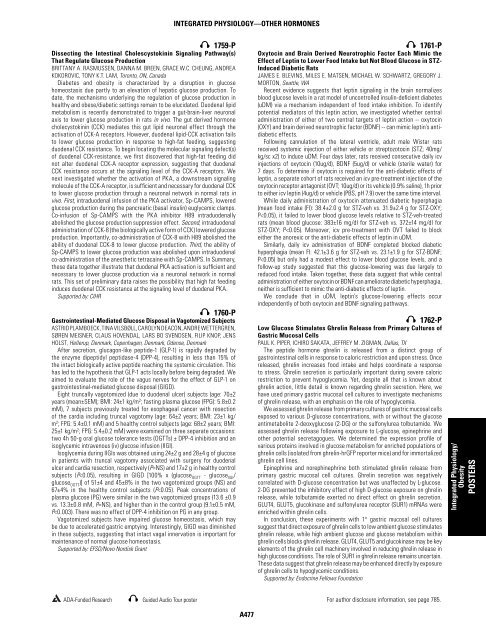2011 ADA Posters 1261-2041.indd - Diabetes
2011 ADA Posters 1261-2041.indd - Diabetes
2011 ADA Posters 1261-2041.indd - Diabetes
Create successful ePaper yourself
Turn your PDF publications into a flip-book with our unique Google optimized e-Paper software.
& 1759-P<br />
Dissecting the Intestinal Cholescystokinin Signaling Pathway(s)<br />
That Regulate Glucose Production<br />
BRITTANY A. RASMUSSEN, DANNA M. BREEN, GRACE W.C. CHEUNG, ANDREA<br />
KOKOROVIC, TONY K.T. LAM, Toronto, ON, Canada<br />
<strong>Diabetes</strong> and obesity is characterized by a disruption in glucose<br />
homeostasis due partly to an elevation of hepatic glucose production. To<br />
date, the mechanisms underlying the regulation of glucose production in<br />
healthy and obese/diabetic settings remain to be elucidated. Duodenal lipid<br />
metabolism is recently demonstrated to trigger a gut-brain-liver neuronal<br />
axis to lower glucose production in rats in vivo. The gut derived hormone<br />
cholecystokinin (CCK) mediates this gut lipid neuronal effect through the<br />
activation of CCK-A receptors. However, duodenal lipid-CCK activation fails<br />
to lower glucose production in response to high-fat feeding, suggesting<br />
duodenal CCK resistance. To begin locating the molecular signaling defect(s)<br />
of duodenal CCK-resistance, we fi rst discovered that high-fat feeding did<br />
not alter duodenal CCK-A receptor expression, suggesting that duodenal<br />
CCK resistance occurs at the signaling level of the CCK-A receptors. We<br />
next investigated whether the activation of PKA, a downstream signaling<br />
molecule of the CCK-A receptor, is suffi cient and necessary for duodenal CCK<br />
to lower glucose production through a neuronal network in normal rats in<br />
vivo. First, intraduodenal infusion of the PKA activator, Sp-CAMPS, lowered<br />
glucose production during the pancreatic (basal insulin) euglycemic clamps.<br />
Co-infusion of Sp-CAMPS with the PKA inhibitor H89 intraduodenally<br />
abolished the glucose production suppression effect. Second, intraduodenal<br />
administration of CCK-8 (the biologically active form of CCK) lowered glucose<br />
production. Importantly, co-administration of CCK-8 with H89 abolished the<br />
ability of duodenal CCK-8 to lower glucose production. Third, the ability of<br />
Sp-CAMPS to lower glucose production was abolished upon intraduodenal<br />
co-administration of the anesthetic tetracaine with Sp-CAMPS. In Summary,<br />
these data together illustrate that duodenal PKA activation is suffi cient and<br />
necessary to lower glucose production via a neuronal network in normal<br />
rats. This set of preliminary data raises the possibility that high fat feeding<br />
induces duodenal CCK resistance at the signaling level of duodenal PKA.<br />
Supported by: CIHR<br />
& 1760-P<br />
Gastrointestinal-Mediated Glucose Disposal in Vagotomized Subjects<br />
ASTRID PLAMBOECK, TINA VILSBØLL, CAROLYN DEACON, ANDRE WETTERGREN,<br />
SØREN MEISNER, CLAUS HOVENDAL, LARS BO SVENDSEN, FILIP KNOP, JENS<br />
HOLST, Hellerup, Denmark, Copenhagen, Denmark, Odense, Denmark<br />
After secretion, glucagon-like peptide-1 (GLP-1) is rapidly degraded by<br />
the enzyme dipeptidyl peptidase-4 (DPP-4), resulting in less than 15% of<br />
the intact biologically active peptide reaching the systemic circulation. This<br />
has led to the hypothesis that GLP-1 acts locally before being degraded. We<br />
aimed to evaluate the role of the vagus nerves for the effect of GLP-1 on<br />
gastrointestinal-mediated glucose disposal (GIGD).<br />
Eight truncally vagotomized (due to duodenal ulcer) subjects (age: 70±2<br />
years (mean±SEM); BMI: 24±1 kg/m 2 ; fasting plasma glucose (FPG): 5.8±0.2<br />
mM), 7 subjects previously treated for esophageal cancer with resection<br />
of the cardia including truncal vagotomy (age: 64±2 years; BMI: 23±1 kg/<br />
m 2 ; FPG: 5.4±0.1 mM) and 5 healthy control subjects (age: 68±2 years; BMI:<br />
25±1 kg/m 2 ; FPG: 5.4±0.2 mM) were examined on three separate occasions:<br />
two 4h 50-g oral glucose tolerance tests (OGTTs) ± DPP-4 inhibition and an<br />
isoglycemic intravenous (iv) glucose infusion (IIGI).<br />
Isoglycemia during IIGIs was obtained using 24±2 g and 28±4 g of glucose<br />
in patients with truncal vagotomy associated with surgery for duodenal<br />
ulcer and cardia resection, respectively (P=NS) and 17±2 g in healthy control<br />
subjects (P
















